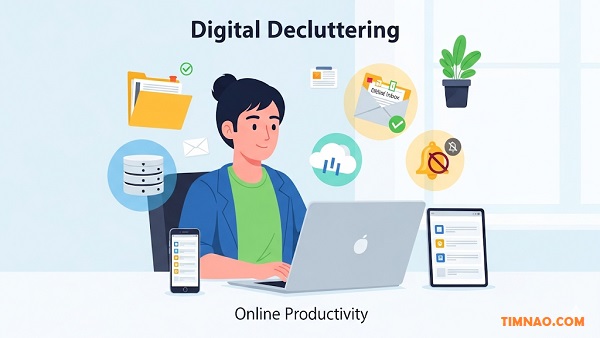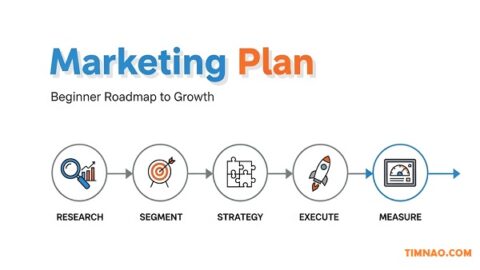🚀 Break Free from Digital Chaos: The Ultimate Guide to Digital Decluttering in 2025 ✨
Digital decluttering is no longer just a nice-to-have—it’s a survival skill in today’s hyperconnected world. With our inboxes overflowing, smartphones buzzing nonstop, and cloud drives packed with forgotten files, many of us feel constantly distracted and drained. Instead of helping us thrive, technology often leaves us stressed and unfocused.
But here’s the shift: when you clear the clutter, you unlock the power of online productivity. A clean digital workspace means less time searching for documents, fewer interruptions from unnecessary notifications, and more energy for the work and relationships that truly matter.
This is where digital minimalism comes in. It’s not about giving up technology but about using it with intention—keeping only what serves you and cutting away the rest. By decluttering, you’re not just tidying up files or apps; you’re reclaiming your time, mental clarity, and peace of mind.
This beginner-friendly guide will walk you through practical steps to simplify your digital life. From organizing your desktop and inbox to rethinking your smartphone habits, you’ll discover how small changes can lead to big improvements in focus, balance, and overall well-being.
Let’s begin your journey toward a calmer, more productive digital world.
📑 Table of Contents
- 🌐 Why Digital Decluttering Matters in 2025
- 🧠 The Hidden Costs of Digital Chaos
- 🛠️ Step 1: Audit Your Digital Life
- 🗂️ Step 2: Organize Your Digital Workspace
- 📧 Step 3: Regain Control of Your Inbox
- 📱 Step 4: Rethink Your Smartphone Habits
- 🤝 Step 5: Declutter Communication & Social Media
- 🎬 Step 6: Simplify Entertainment & Subscriptions
- ☁️ Step 7: Manage Files, Photos & Cloud Storage
- 🧘 Step 8: Embrace Digital Minimalism & Mindful Tech Use
- 🔄 Step 9: Schedule Regular Digital Detox Sessions
- ⚡ Tools & Apps to Support Your Journey
- 🌟 Building a Balanced Digital Life
🌐 Why Digital Decluttering Matters in 2025
Technology in 2025 is both a blessing and a burden. We rely on our devices for almost everything—work, shopping, communication, and entertainment. But with that convenience comes a hidden cost: endless files, apps, and notifications competing for our attention.
Unlike a messy desk, digital clutter doesn’t pile up in front of your eyes. It sneaks into your inbox, fills your cloud storage, and hides behind every notification bubble. You may not see it, but you feel it every day in the form of stress, distraction, and wasted time.
That’s where digital decluttering comes in. It’s not about giving up technology but about making it work for you instead of against you. When you intentionally clear the noise, you make space for focus, creativity, and balance. This is the core of digital minimalism—keeping only what matters and letting go of the rest.
In a world where online productivity is more essential than ever, decluttering your digital life is no longer optional. It’s a skill that protects your attention and gives you back control of your time.
🧠 The Hidden Costs of Digital Chaos
If you’ve ever felt overwhelmed by your phone or computer, you’ve already experienced the effects of digital clutter. Here are some of the hidden ways it drags you down:
- Time drain: Hours wasted searching for files or scrolling past endless messages.
- Mental stress: A cluttered inbox or constant notifications creates low-level anxiety.
- Reduced focus: Too many digital distractions make it harder to do deep, meaningful work.
- Decision fatigue: Every alert or extra file forces micro-decisions that chip away at your energy.
- Money leaks: Paying for unnecessary subscriptions or extra storage because of clutter.
These costs don’t hit all at once. They creep in slowly, making you less efficient and more stressed over time.
⚡ Small Shifts You Can Try Today
You don’t need a big cleanup right away. Start with tiny steps that give you a taste of clarity:
- Turn off one non-essential notification. Pick an app that interrupts you most and silence it.
- Delete five old photos or screenshots. A small but satisfying win that lightens your digital load.
- Write down three areas of clutter that bother you most. This helps you see where to focus when you’re ready for a full cleanup.
These small moves won’t solve everything, but they’ll give you a sense of control. More importantly, they help you feel the immediate benefits of digital decluttering—less stress, more focus, and a bit more breathing room in your day.
🛠️ Step 1: Audit Your Digital Life
Before you start cleaning up, you need to see the mess clearly. That’s what an audit is for—taking a snapshot of your current digital life so you know exactly what you’re dealing with. Think of it as checking the fridge before grocery shopping. You don’t buy new food until you know what’s already there.
Most people underestimate how much digital clutter they’ve collected. By pausing to review, you avoid wasting time fixing the wrong things. Here’s a beginner-friendly way to do a digital audit in less than 30 minutes.
1. Check Your Desktop and Downloads
Open your computer desktop. Is it covered with random files, screenshots, or shortcuts? Write down roughly how many items are sitting there. Then check your Downloads folder. For many, it’s a graveyard of PDFs, duplicate images, and software installers. Count the number of files—don’t clean yet, just notice.
2. Look at Your Email Inbox
How many unread messages do you see? 200? 2,000? More? Don’t let the number scare you. The point here is not to empty your inbox but to become aware of the backlog. Email clutter often carries hidden stress, so recording the number is an eye-opener.
3. Review Your Smartphone Apps
Pick up your phone and scroll through all the apps. Which ones do you use daily? Weekly? Which haven’t you touched in months? Make two quick lists: “essential” and “non-essential.” This will help later when you decide what to uninstall or hide.
4. Scan Your Photos and Cloud Storage
Open your photo gallery. How many total pictures do you have? Most people keep thousands, but many are duplicates, blurry shots, or screenshots. If your cloud storage is almost full, jot that down too. This is an area where small cleanups can save money on extra storage fees.
5. List Your Subscriptions
Subscriptions are easy to forget because they renew silently. Check your phone’s app store or your bank statement for recurring digital payments. Write them all down and mark the ones you barely use.
📋 Quick Audit Checklist (15 minutes)
- Count files on your desktop.
- Count files in your Downloads folder.
- Record number of unread emails.
- List apps you haven’t used in 30+ days.
- Note total photos/videos on your phone.
- List all active digital subscriptions.
This isn’t about perfection—it’s about awareness. Once you’ve got this snapshot, you’ll know exactly where your biggest clutter problems are. That way, when you start decluttering, you’ll focus on what really matters instead of guessing.
🗂️ Step 2: Organize Your Digital Workspace
Once you know where the clutter is, it’s time to give your digital life some structure. The workspace is the best place to start because it’s where you spend the most time. A clean, organized workspace boosts online productivity immediately—you’ll feel lighter and more in control the moment you log in.
1. Clear Your Desktop
Your desktop should be like a clean desk at work. Keep only what you’re actively using. Create one folder called “To Sort” and move everything else there. From now on, when you save new files, put them directly into the right folders instead of cluttering your desktop.
2. Build a Simple Folder System
A folder system is like a filing cabinet—it saves time and prevents future chaos. Start with just four main folders:
- Work
- Personal
- Finance
- Media (Photos, Videos, Music)
Inside each folder, add subfolders that make sense for your life. For example, “Work” could have “Clients,” “Projects,” and “Reports.” Keep it simple—if you create too many categories, you’ll end up confused again.
3. Create File-Naming Rules
Nothing slows you down like files named “Final_V3_EDITED.” Instead, create a simple naming system you can stick to. For example:
- ProjectName_Date_Version → “WebsiteUpdate_Feb2025_v1”
- Finance_Type_Date → “Invoice_March2025”
Consistency is the secret. When every file follows the same pattern, you’ll find what you need in seconds.
4. Empty the Downloads Folder Regularly
Your Downloads folder is a magnet for clutter. Make it a rule: once a week, empty it. Move useful files to the right folder and delete the rest. To make it easier, set a reminder in your calendar—this tiny habit saves hours later.
5. Streamline with Tools
If you struggle to stay organized, let apps help you. Tools like Notion and Evernote keep notes and projects tidy. Google Drive or Dropbox are great for shared files. For computer cleanup, apps like CCleaner clear junk automatically. Pick what works for you and stick with it.
6. Practice Digital Minimalism
Organization doesn’t mean keeping everything in neat folders. It also means deleting what you don’t need. Ask yourself: “Will I need this in six months?” If the answer is no, delete it. The less digital baggage you carry, the faster and calmer your workflow will feel. This is the essence of digital minimalism—choosing clarity over clutter.
🚀 Quick Workspace Fix (30 minutes)
- Create the 4 main folders (Work, Personal, Finance, Media).
- Move everything from your desktop into the right folder—or temporarily into “To Sort.”
- Rename 10 important files using your new naming system.
- Clear your Downloads folder.
- Delete 5 files or apps you know you’ll never use.
These small steps might feel simple, but the effect is huge. A clean workspace gives you confidence and removes friction from your daily tasks. Every time you open your laptop or phone, you’ll notice less stress and more focus.
📧 Step 3: Regain Control of Your Inbox
Email was supposed to make life easier, but for many people, it has turned into a digital swamp. A cluttered inbox filled with unread messages and endless newsletters creates constant low-level stress. If your inbox feels out of control, you’re not alone—most beginners struggle with this. The good news is you don’t need to hit “inbox zero” on day one. You just need a system that makes email manageable again.
1. Start with a Clean Slate Folder
Don’t waste hours sorting thousands of old emails. Instead, create a folder called “Archive 2025” (or any name you like). Move everything older than one month into it. Now your inbox shows only recent and relevant messages. If you need something from the past, you can still search for it in the archive. This instantly reduces overwhelm.
2. Use the 2-Minute Rule
When a new email comes in, ask yourself: “Can I deal with this in under 2 minutes?” If yes, reply, archive, or delete right away. If not, move it to a folder called “To Do” and handle it later in your focused work time. This prevents your inbox from turning into a giant task list.
3. Unsubscribe Ruthlessly
Newsletters and promotions are the biggest culprits behind email overload. Pick one week to scan your incoming emails and hit “unsubscribe” on anything you don’t read regularly. If unsubscribing feels tiring, use a free tool like Unroll.Me to batch unsubscribe in minutes.
4. Create Smart Filters and Labels
Most email services let you set up filters. For example:
- All invoices → “Finance” folder.
- All social media notifications → “Social” folder.
- All newsletters → “Read Later” folder.
This keeps your main inbox clean so you can focus on important emails first.
5. Limit Inbox Checks
Constantly refreshing your inbox kills productivity. Set boundaries: check email 2–3 times a day—say, morning, afternoon, and evening. Turn off push notifications on your phone so you’re not interrupted every five minutes.
📋 Quick Inbox Reset (30 minutes)
- Create an “Archive 2025” folder → move old emails.
- Unsubscribe from 5 newsletters.
- Set up 1 filter (e.g., invoices).
- Use the 2-minute rule for new emails today.
- Decide on your inbox check times.
These small shifts transform email from a constant distraction into a tool you control. The relief of seeing a cleaner inbox will motivate you to keep the habit going.
📱 Step 4: Rethink Your Smartphone Habits
If email drains your energy, your smartphone might be draining your entire attention span. Phones are designed to keep you hooked—every ping, buzz, and red notification dot is a trigger. Without boundaries, they steal hours of your day without you realizing it.
The goal of this step isn’t to throw away your phone. Instead, it’s about using it with intention. Here’s how beginners can quickly build healthier smartphone habits.
1. Audit Your Apps
Scroll through your home screen. How many apps do you actually use daily? Probably less than half. Delete the ones you never touch. For apps you use only occasionally, move them to a separate folder on the last screen so they’re out of sight. This simple change reduces temptation.
2. Turn Off Non-Essential Notifications
Not every app deserves your attention. Go to your settings and disable notifications for social media, shopping, or game apps. Keep alerts only for essentials—like calls, calendar reminders, or banking apps. This cuts interruptions dramatically.
3. Organize Your Home Screen for Focus
Put the apps you use for productivity (calendar, notes, email) on the first screen. Hide distracting apps like Instagram or TikTok in a separate folder. This way, when you unlock your phone, you see tools, not temptations.
4. Set App Time Limits
Most smartphones now have “Screen Time” (iOS) or “Digital Wellbeing” (Android) features. Use them to limit daily usage of apps that waste your time. Even setting a 30-minute limit on social media can free up hours each week.
5. Create Phone-Free Zones
Pick certain times or spaces where your phone doesn’t belong—like during meals, in the bedroom, or the first hour after waking up. These breaks reduce digital dependency and give your brain room to recharge.
6. Use Do Not Disturb Wisely
When working or relaxing, turn on Do Not Disturb mode. You can allow calls from important contacts while silencing everything else. This way, your phone supports your focus instead of constantly breaking it.
📋 Quick Smartphone Reset (20 minutes)
- Delete 3 unused apps.
- Turn off notifications for 3 distracting apps.
- Move social media apps into a hidden folder.
- Set 1 app time limit today.
- Choose 1 phone-free zone (like the dining table).
By making these small but powerful adjustments, your phone transforms from a source of stress into a tool for clarity. Instead of reacting to it all day, you’ll start using it on your terms.
🤝 Step 5: Declutter Communication & Social Media
Staying connected is essential, but too much digital communication can leave you drained. Between messaging apps, group chats, Slack channels, and social media, you may feel like you’re always “on call.” This constant stream of pings chips away at focus and makes it hard to enjoy offline life.
Digital decluttering here isn’t about cutting yourself off from friends or deleting every app. It’s about regaining balance—so your communication tools work for you, not against you.
1. Audit Your Communication Channels
Start by listing the apps you use to communicate: WhatsApp, Messenger, Slack, Discord, SMS, etc. Do you really need all of them? Many beginners discover they use 4–5 platforms for the same conversations. Consolidate where you can—encourage close contacts to use one main app.
2. Trim Group Chats
Group chats are useful, but they can spiral into noise. Ask yourself: does this group still serve a purpose? If not, mute or exit. For the groups you keep, mute notifications and check them only when convenient.
3. Use “Do Not Disturb” Hours
Set quiet hours when your messaging apps won’t buzz, such as during deep work or evenings. Most apps have built-in mute features. This helps separate work from personal time and reduces the feeling of being “always available.”
4. Rethink Social Media
Social media is the trickiest form of digital clutter. It’s not just about notifications—it’s about attention traps. To regain control:
- Unfollow aggressively. Keep only accounts that inspire, educate, or genuinely connect with you.
- Set time limits. Use your phone’s digital wellbeing tools to cap social media use.
- Move apps off your home screen. Out of sight, out of mind.
5. Practice “Intentional Use”
Instead of mindlessly scrolling, ask: Why am I opening this app right now? Is it to relax, to learn, to connect? When you use social media with intention, it becomes a tool instead of a time thief.
📋 Quick Communication Reset (20 minutes)
- Write down all your communication apps.
- Delete or stop using one that duplicates another.
- Mute 2 group chats that drain your energy.
- Unfollow 10 social media accounts today.
- Set Do Not Disturb hours for evenings.
By streamlining communication, you create fewer interruptions and more meaningful interactions. That’s the heart of digital minimalism—quality over quantity.
🎬 Step 6: Simplify Entertainment & Subscriptions
Entertainment should help you relax—not add stress to your digital life. But in 2025, many people are drowning in streaming services, gaming apps, and endless subscription offers. The result? Money wasted, choice overload, and hours lost to passive consumption.
Simplifying this area is one of the fastest ways to reclaim time, focus, and even cash.
1. Audit Your Subscriptions
List every paid subscription you currently have: Netflix, Spotify, Disney+, YouTube Premium, game passes, cloud storage, even fitness apps. Then ask: Do I use this at least once a week? If not, cancel it.
2. Cut Down Streaming Overload
With so many platforms competing, it’s easy to pay for three or four services but only use one. Pick your favorite, keep it, and pause the rest. Most services let you cancel and restart anytime—so you can rotate without paying for all of them at once.
3. Manage Free Entertainment Apps
Free apps like TikTok, YouTube, or mobile games don’t cost money, but they cost attention. If you find yourself spending hours scrolling, set limits. Move these apps to a folder so they’re not instantly accessible, or delete them for a week to break the habit.
4. Choose Active Over Passive Entertainment
Not all entertainment is equal. Watching three hours of random videos leaves you drained, while an hour of reading, learning, or creative hobbies leaves you energized. Apply digital decluttering principles to your free time too—choose fewer, better activities that align with your values.
5. Review Costs Regularly
Subscriptions love to slip under the radar. Set a calendar reminder to review your subscriptions every three months. Cancel what you’re not using. Even saving $10–$20 a month adds up quickly over a year.
📋 Quick Subscription Reset (15 minutes)
- Write down every subscription you pay for.
- Cancel one you rarely use.
- Rotate between services instead of keeping all.
- Delete one entertainment app that drains your time.
- Schedule a 3-month reminder for subscription review.
By simplifying your entertainment and subscriptions, you’ll reduce financial clutter and reclaim your free time. The reward is not just saving money—it’s having more mental space for the things that genuinely bring you joy.
☁️ Step 7: Manage Files, Photos & Cloud Storage
One of the most invisible forms of clutter lives inside your files and photos. You might not see it every day, but the moment you need an important document or a picture, the chaos shows itself. Wasting 15 minutes searching through poorly named folders or scrolling through thousands of screenshots is frustrating—and it kills online productivity.
The good news: a few smart habits can transform this digital mess into an organized, stress-free system.
1. Start with a Simple Folder Structure
Don’t overcomplicate. Create 3–4 main folders (Work, Personal, Finance, Media). Inside each, add only the subfolders you truly need. For example, “Work” could include Clients, Projects, and Reports. Keep it flat and simple—nested folders only make it harder to find things.
2. Apply a File-Naming Convention
A file with the name “final_v2_reallyFINAL.docx” is a nightmare waiting to happen. Instead, use a clear pattern like:
ProjectName_Date_Version→ “MarketingPlan_2025-03_v1”Invoice_2025-08_ClientName
Pick one system and stick to it. This small rule saves hours over time.
3. Tame the Downloads Folder
The Downloads folder is digital quicksand. Every week, set aside 10 minutes to sort or delete. Better yet, adjust your browser settings so it always asks where to save files. That way, documents go directly into the right folder instead of piling up.
4. Declutter Photos in Small Batches
Most beginners struggle with photo clutter—thousands of pictures, many of them duplicates or screenshots. Instead of tackling everything at once, start with 5–10 minutes daily:
- Delete duplicates and blurry shots.
- Use apps like Gemini Photos or Google Photos to identify similar images.
- Create albums for important events so memories are easy to revisit.
5. Optimize Cloud Storage
Cloud services like Google Drive, Dropbox, and iCloud are lifesavers—but they also become cluttered fast. Apply the same folder structure and naming rules as on your computer. If you’re paying for storage, review what’s eating space. You may discover old backups or unnecessary duplicates costing you money.
6. Backup Smartly
Instead of random hard drives or forgotten USB sticks, choose one reliable backup method. Options:
- An external hard drive updated monthly.
- A trusted cloud backup tool like Backblaze.
Consistency is more important than perfection—just make sure you have one reliable copy of your important files.
📋 Quick File & Photo Reset (30 minutes)
- Create 4 main folders (Work, Personal, Finance, Media).
- Move all desktop files into the right folder.
- Rename 10 files with your new naming convention.
- Delete 20 old photos or screenshots today.
- Review your cloud storage and clear at least 200 MB.
With these small actions, your files and photos go from chaotic to calm. Searching becomes easier, storage costs drop, and you gain confidence that your digital life is under control.
🧘 Step 8: Embrace Digital Minimalism & Mindful Tech Use
Up to this point, we’ve focused on cleaning and organizing. But decluttering isn’t just about deleting—it’s about creating a healthier relationship with technology. That’s where digital minimalism and mindful tech use come in.
1. Redefine What “Enough” Looks Like
Minimalism doesn’t mean deleting everything. It means keeping only what supports your goals and well-being. For beginners, this might mean having:
- One or two main communication apps instead of five.
- One streaming service instead of three.
- A clean workspace instead of 100 desktop icons.
Ask yourself: Does this tool make my life better, or is it just adding noise?
2. Set Intentional Tech Boundaries
Mindless scrolling or constant multitasking eats up your energy. Instead, create “tech rules” that support balance:
- No phones during meals.
- Social media only after work.
- Screens off 30 minutes before bedtime.
These boundaries protect your attention and make room for real rest.
3. Practice Single-Tasking
Multitasking feels productive, but it actually reduces efficiency. Try focusing on one digital task at a time—replying to emails, editing a file, or watching a video—without toggling between apps. You’ll finish faster and feel less drained.
4. Add More Offline Moments
Digital minimalism isn’t just about deleting—it’s about creating space for offline joys. Read a physical book, go for a walk without your phone, or spend an evening without screens. These breaks refresh your mind and reduce digital fatigue.
5. Review and Adjust Regularly
Your needs will change over time. What feels essential today may become clutter next year. Schedule a short “digital review” every 3 months. Ask: What’s adding value? What feels like noise? Then adjust accordingly.
📋 Quick Mindful Tech Reset (15 minutes)
- Delete one app you don’t truly need.
- Set a phone-free time during dinner.
- Try single-tasking for your next work session.
- Spend 20 minutes today on an offline activity.
- Journal one insight about how tech makes you feel.
When you practice digital minimalism, technology stops being a master and becomes a partner. Instead of drowning in endless apps, files, and subscriptions, you build a life with more clarity, calm, and purpose.
🔄 Step 9: Schedule Regular Digital Detox Sessions
Even if you’ve done a full round of digital decluttering, the truth is clutter will slowly creep back in. Notifications pile up, apps get reinstalled, and cloud storage fills again. That’s why it’s crucial to treat digital balance as an ongoing habit, not a one-time event.
The simplest way? Schedule regular digital detox sessions. Think of them like cleaning days for your digital life—they reset your mind and help you catch small problems before they become overwhelming.
1. Find Your Detox Rhythm
There’s no one-size-fits-all. Beginners can try:
- Daily detox: Spend 30–60 minutes screen-free before bedtime.
- Weekly detox: Take a Sunday morning offline—no social media, no emails.
- Monthly detox: Dedicate one weekend day to offline hobbies and reflection.
Start with something realistic. A short, consistent detox is far better than trying to go offline for a week and giving up after day one.
2. Create Phone-Free Zones
Designate areas or times where devices aren’t welcome—like the dining table, bedroom, or during workouts. By physically separating yourself from screens, you make it easier to disconnect without relying on sheer willpower.
3. Replace Scrolling with Intentional Activities
Detox doesn’t mean boredom. Plan alternatives: read a paperback book, cook a meal, take a walk, or invite friends over. The goal is to fill your time with activities that recharge you instead of draining your energy.
4. Apply the 80/20 Rule to Tech
Ask yourself: Which 20% of my digital tools give me 80% of the value? Keep those front and center. Use detox sessions to pause or delete the rest, even temporarily.
5. Reflect and Adjust
After each detox, take five minutes to journal: How did you feel? Did you sleep better? Did you notice less stress? Reflection helps you understand the benefits and motivates you to keep going.
📋 Quick Detox Reset (15 minutes)
- Schedule a 1-hour phone-free block this week.
- Choose one “no phone” zone at home.
- Plan 3 offline activities you enjoy.
- Turn off all notifications during detox time.
- Write down one feeling after the session.
Small, repeated detoxes create space for clarity, making digital minimalism easier to maintain and supporting long-term online productivity.
⚡ Tools & Apps to Support Your Journey
Ironically, the right technology can help you manage digital overload. The key is to use tools intentionally, not to add more clutter. For beginners, here are trusted apps and services that make digital decluttering easier:
1. File & Storage Management
- Google Drive → Cloud storage with powerful search and easy file sharing.
- Dropbox → Simple, reliable syncing across devices.
- CCleaner → Cleans junk files and boosts computer performance.
- Gemini Photos (iOS) → Quickly finds duplicate and blurry photos.
- Google Photos (Android & iOS) → Smart photo backup and organization.
2. Focus & Productivity
- Forest → Stay off your phone by growing a virtual tree.
- RescueTime → Tracks how you spend time online and shows productivity trends.
- Cold Turkey Blocker → Blocks distracting websites and apps on desktop.
3. Inbox & Communication
- Unroll.Me → Unsubscribe from unwanted newsletters in bulk.
- Spark Mail → Smart email client that prioritizes important messages.
- Slack / Microsoft Teams → Great for team collaboration (but remember to mute notifications when needed).
4. Digital Minimalism & Screen Habits
- Screen Time (iOS) / Digital Wellbeing (Android) → Built-in tools to monitor and limit app usage.
- Freedom → Blocks websites or apps across devices during focused work.
- Notion / Evernote → Keep notes, tasks, and projects organized in one place.
5. The Rule of Three for Beginners
Don’t overload yourself with apps to manage apps. Stick to:
- One storage tool (Google Drive or Dropbox).
- One focus tool (Forest or RescueTime).
- One organization tool (Notion or Evernote).
This keeps your toolkit lean, aligned with digital minimalism, and avoids turning “productivity” into another clutter problem.
📋 Quick Tool Reset (20 minutes)
- Pick and set up one cloud storage service.
- Install one focus app like Forest or RescueTime.
- Try one email cleanup tool (Unroll.Me or Spark).
- Activate Screen Time or Digital Wellbeing for one app limit.
- Delete apps you tested but never use.
🌟 Building a Balanced Digital Life
So far, you’ve learned how to clean up files, streamline your inbox, manage photos, and even take breaks from screens. But digital decluttering isn’t just about reducing—it’s about building balance. Balance means your devices and apps support your goals instead of distracting you.
Think of it like designing a home: once you’ve cleared the clutter, you arrange your space so it feels welcoming, practical, and aligned with your lifestyle. The same goes for your digital life.
1. Define Your “Digital Priorities”
Start by asking: What do I want technology to do for me? For example:
- Stay productive at work → use tools like Notion or Google Drive.
- Keep memories safe → organize with Google Photos or Dropbox.
- Maintain well-being → set limits with Digital Wellbeing or Screen Time.
By clarifying your goals, you stop chasing every new app and focus only on what adds real value.
2. Balance Work, Play, and Rest
One common trap is letting work bleed into personal time—checking emails at dinner or answering Slack messages before bed. Balance means:
- Use separate profiles or browsers for work and personal tasks.
- Silence notifications outside of working hours.
- Protect downtime with scheduled “offline hours.”
This helps you feel more present in both work and life.
3. Embrace the 80/20 Rule for Digital Tools
Keep the 20% of apps that bring you 80% of value. Delete the rest or keep them tucked away in folders. Less clutter = less decision fatigue, which boosts online productivity.
4. Revisit & Refresh Every Quarter
Your digital needs evolve. Every 3 months, set aside 30 minutes to review:
- Do I still need this app or subscription?
- Is my file structure working, or do I need to simplify further?
- Have my digital boundaries slipped?
This ensures your balance lasts long-term instead of being a one-time fix.
📋 Quick Balance Reset (20 minutes)
- Write down your 3 top digital priorities.
- Set “Do Not Disturb” during your rest hours.
- Review and cancel one unused subscription.
- Move distracting apps into a hidden folder.
- Plan your next quarterly refresh date.
When you approach digital minimalism this way, your phone and computer stop being noisy taskmasters—and instead become quiet, reliable partners that help you live a calmer, more intentional life.
🙋 FAQs: Beginner Questions About Digital Decluttering Answered
Beginners often feel unsure where to start. Here are some of the most common questions and simple, practical answers:
1. How do I know if I need digital decluttering?
If you feel stressed by notifications, struggle to find files, or spend more time scrolling than creating, it’s a sign. Even 10 minutes of clutter clearing can make a difference.
2. Do I have to delete everything?
No. Digital minimalism isn’t about extremes. It’s about keeping what matters and letting go of what distracts you. For instance, you might keep Instagram for creative inspiration but delete TikTok if it drains hours daily.
3. I’m afraid I’ll lose important files or photos. What should I do?
Start by backing everything up to Google Drive, Dropbox, or an external hard drive. Then sort slowly, knowing you can always restore what you need.
4. How much time should I spend decluttering each week?
You don’t need hours. Begin with 10–15 minutes daily, or schedule one 30-minute session weekly. Consistency beats intensity.
5. What if I can’t keep up?
That’s normal—digital decluttering is a journey. If you slip, just restart with one small action, like deleting 10 old photos or unsubscribing from one newsletter. Small wins build momentum.
6. Is there an app that will declutter everything for me?
Unfortunately, no single app can handle it all. But a combination works:
- Gemini Photos for duplicate pictures.
- Unroll.Me for email cleanup.
- Freedom for blocking distractions.
7. How does digital decluttering improve online productivity?
When your files, apps, and notifications are streamlined, you spend less time searching or fighting distractions. That extra energy goes into actual work or creativity, not digital chaos.
8. Can kids or families practice digital decluttering too?
Yes! Families can agree on “device-free dinners,” shared photo albums instead of scattered ones, or screen limits for kids. It’s a great way to teach mindful tech habits early.
📋 Quick FAQ Reset (10 minutes)
- Answer for yourself: What’s one app I don’t truly need? Delete it.
- Pick a 10-minute slot this week to tidy files or photos.
- Back up one important folder today.
- Create one family “no phone” rule (like meals).
- Journal how your energy feels after a small declutter.









